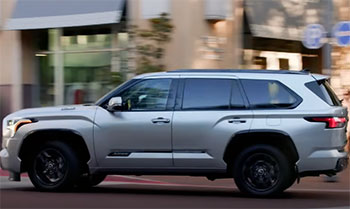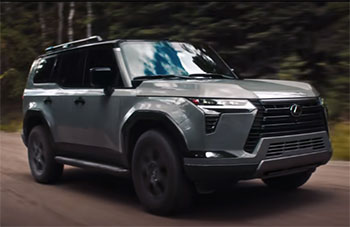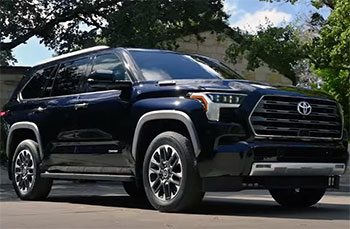I’ve always been fascinated by SUVs that blend rugged capability with luxury, and when it came time to choose my next vehicle, I found myself torn between the 2025 Toyota Sequoia and the 2024 Lexus GX 550. Both are body-on-frame SUVs built for families who want space, power, and off-road prowess without sacrificing comfort.
In this article, I’ll share my firsthand experience comparing these two, breaking down their strengths and weaknesses to help you decide which one fits your lifestyle. From performance to interior luxury, I’ll cover it all to guide your choice.
Comparison Table: Toyota Sequoia Vs. Lexus GX
| Feature | 2025 Toyota Sequoia | 2024 Lexus GX 550 |
|---|---|---|
| Starting MSRP | $61,275 (SR5 RWD) | $64,735 (Premium 4WD) |
| Engine | 3.5L V6 Hybrid, 437 hp, 583 lb-ft | 3.4L V6 Turbo, 349 hp, 353 lb-ft |
| Fuel Economy (City/Highway/Combined) | 21/24/22 MPG | 15/21/17 MPG |
| Cargo Capacity | 22.3 ft³ (seats up), 86.9 ft³ (max) | 10.3 ft³ (seats up), 76.9 ft³ (max) |
| Seating Capacity | Up to 8 | Up to 7 |
| Towing Capacity | Up to 9,520 lbs | Up to 6,990 lbs |
| Ground Clearance | 8.7 inches | 8.7 inches |
| Infotainment | 8″ or 14″ touchscreen, Apple CarPlay, Android Auto | 10.3″ or 14″ touchscreen, Apple CarPlay, Android Auto |
| Warranty | 36 months/60,000 km (comprehensive) | 48 months/80,000 km (comprehensive) |
| Maintenance Plan | 2 years/25,000 miles | 1 year/10,000 miles |
My Experience With the Toyota Sequoia

Driving the 2025 Toyota Sequoia felt like commanding a fortress on wheels.
Its massive size—208 inches long and 80 inches wide—gave me confidence on the highway, and the hybrid powertrain delivered a surprising punch.
The i-Force Max system, combining a twin-turbo 3.5-liter V6 with an electric motor, churns out 437 horsepower and 583 lb-ft of torque.
I was impressed by how effortlessly it accelerated, especially when merging onto busy interstates.
Towing my friend’s boat, which weighed close to 7,000 pounds, was a breeze with its 9,520-pound towing capacity.
The interior is where the Sequoia shines for families. With three rows and seating for up to eight, it’s a people-hauler’s dream.
I took my family of six on a weekend camping trip, and everyone had room to stretch out.
The second row, with 39.2 inches of legroom, kept my teenagers happy, and the third row was surprisingly comfortable for adults on shorter drives. The 22.3 cubic feet of cargo space behind the third row swallowed our gear without complaint, though I wished the third row could fold flat for a smoother cargo floor.
Off-road, the Sequoia’s TRD Pro trim was a beast. With 8.7 inches of ground clearance and skid plates, it tackled a muddy trail with ease. The hybrid system’s torque made climbing steep inclines feel effortless, though the vehicle’s size made tight trails a bit tricky. On the road, the ride was smooth, but I noticed some body roll in sharp turns, reminding me of its truck-based roots.
The tech suite was solid but not flashy. The standard 8-inch touchscreen (upgradable to 14 inches) was responsive, with wireless Apple CarPlay and Android Auto keeping me connected. The safety features, like blind-spot monitoring and adaptive cruise control, gave me peace of mind in traffic. However, the Sequoia’s fuel economy—21 MPG city and 24 MPG highway—was a standout for a vehicle this size, thanks to the hybrid system.
Overall, the Sequoia felt like a practical choice for someone like me who needs space, towing power, and reliability. It’s not as polished as some luxury SUVs, but its rugged charm and family-friendly features won me over.
Pros Of the Toyota Sequoia
- Powerful Hybrid Engine: The i-Force Max hybrid delivers 437 horsepower and 583 lb-ft of torque, making it a powerhouse for towing and acceleration. I towed a 7,000-pound trailer without breaking a sweat, and the electric motor’s instant torque made highway passing a breeze.
- Spacious Interior: With seating for up to eight and 39.2 inches of second-row legroom, the Sequoia is perfect for large families. My kids had plenty of space, and the third row accommodated adults comfortably for short trips.
- Impressive Cargo Capacity: Offering 22.3 cubic feet behind the third row and up to 86.9 cubic feet with seats folded, it handled all my camping gear easily. I packed coolers, tents, and bags without needing to play cargo Tetris.
- Excellent Fuel Economy: At 21 MPG city and 24 MPG highway, the Sequoia’s hybrid system beats most full-size SUVs. I saved noticeable fuel costs compared to non-hybrid competitors during a 300-mile road trip.
- Robust Towing Capability: With a 9,520-pound towing capacity, it’s ready for boats, trailers, or campers. I felt confident towing heavy loads, knowing the Sequoia had power to spare.
- Reliable Safety Features: Standard features like blind-spot monitoring, lane-keep assist, and adaptive cruise control made driving stress-free. The surround-view camera was a lifesaver when parking in tight spots.
- Longer Maintenance Plan: Toyota’s 2-year/25,000-mile maintenance plan outshines the Lexus GX’s 1-year/10,000-mile offering, saving me money on early upkeep.
Cons Of the Toyota Sequoia
- Non-Folding Third Row: The third row doesn’t fold flat, creating an uneven cargo floor. I struggled to stack larger items like a cooler evenly when the seats were stowed.
- Bulky Handling: The Sequoia’s size and 5,600-pound weight make it feel cumbersome in tight spaces. Navigating narrow trails or crowded parking lots required extra care.
- Basic Interior Materials: While functional, the interior lacks the premium feel of competitors. The plastic trim in the SR5 trim felt cheap compared to the leather-heavy Lexus GX.
- Higher Starting Price: At $61,275, it’s slightly pricier than some rivals like the Ford Expedition. I had to stretch my budget to get the features I wanted.
- Limited Off-Road Agility: Despite 8.7 inches of ground clearance, the Sequoia’s long wheelbase made it less nimble on tight off-road trails compared to the smaller GX.
- Noisy Cabin at High Speeds: Highway driving brought noticeable wind and tire noise, which was distracting during long trips. I expected better sound insulation for the price.
My Experience With the Lexus GX 550

The 2024 Lexus GX 550 was a different beast altogether—sleek, luxurious, and rugged in a refined way.
Its 3.4-liter turbocharged V6 engine, producing 349 horsepower and 353 lb-ft of torque, felt responsive but less muscular than the Sequoia’s hybrid.
I took it on a mountain road, and while it handled curves better than the Sequoia, it lacked the same raw power for towing. Its 6,990-pound towing capacity was sufficient for my small trailer but fell short for heavier loads.
The GX’s interior screamed luxury. The semi-aniline leather seats in the Luxury+ trim were buttery soft, and the massaging front seats were a game-changer on long drives.
With seating for seven, it was slightly less spacious than the Sequoia, but my family of six fit comfortably. The third row, however, was tighter, better suited for kids than adults. Cargo space was a letdown—only 10.3 cubic feet behind the third row, which meant I had to pack light for road trips.
Off-road, the GX 550 Overtrail trim was a revelation. With adaptive suspension and crawl control, it glided over rocky terrain like a mountain goat. The 8.7 inches of ground clearance matched the Sequoia, but the GX’s shorter wheelbase made it more agile on narrow trails. On the highway, the ride was smooth and quiet, with less body roll than the Sequoia, making it a joy for daily driving.
The tech was top-notch, with a 14-inch touchscreen option that was crisp and intuitive. Apple CarPlay and Android Auto worked seamlessly, and the 10-speaker audio system sounded fantastic. Safety features mirrored the Sequoia’s, but the GX added a premium touch with its surround-view monitor and parking assist. Fuel economy was a downside—15 MPG city and 21 MPG highway meant more frequent gas station stops.
The GX felt like a luxury adventure machine, perfect for someone who wants refinement with off-road capability. It’s not as family-focused as the Sequoia but excels in style and agility.
Read More: My Thoughts On Ford Escape Vs. Mazda CX-5
Pros Of the Lexus GX 550
- Luxurious Interior: The semi-aniline leather and massaging seats in the Luxury+ trim felt indulgent. I loved the premium wood trim and soft-touch surfaces that elevated every drive.
- Nimble Off-Road Performance: The Overtrail trim’s adaptive suspension and crawl control made off-roading a breeze. I tackled rocky trails with confidence, thanks to its agile handling.
- Quiet Cabin: The GX’s sound insulation kept wind and tire noise to a minimum, creating a serene environment. Long drives were peaceful, even at 70 MPH.
- Advanced Tech Suite: The optional 14-inch touchscreen was responsive, and the 10-speaker audio system delivered crystal-clear sound. I enjoyed seamless smartphone integration.
- Refined Ride Quality: With less body roll than the Sequoia, the GX handled curves smoothly. It felt more like a luxury crossover than a truck-based SUV on the road.
- Premium Safety Features: Features like parking assist and a surround-view camera made urban driving stress-free. I parked in tight spaces without breaking a sweat.
- Longer Warranty: The 48-month/80,000-km comprehensive warranty outlasts the Sequoia’s 36-month/60,000-km coverage, giving me extra peace of mind.
Cons Of the Lexus GX 550
- Limited Cargo Space: With only 10.3 cubic feet behind the third row, packing for family trips was a challenge. I had to leave some gear behind to fit everything.
- Poor Fuel Economy: At 15 MPG city and 21 MPG highway, the GX was thirstier than the Sequoia. My fuel costs added up quickly on long drives.
- Lower Towing Capacity: The 6,990-pound towing limit was adequate for small trailers but couldn’t handle heavier loads like the Sequoia. I felt limited in towing options.
- Cramped Third Row: The third row was tight for adults, making it less practical for large families. My taller friends struggled on even short rides.
- Higher Starting Price: Starting at $64,735, the GX is pricier than the Sequoia. I had to justify the extra cost for its luxury features.
- Less Powerful Engine: The 349-horsepower V6 felt underpowered compared to the Sequoia’s hybrid. I noticed the difference when accelerating uphill.
Comparing Key Features in Detail
Performance and Powertrain
The Sequoia’s i-Force Max hybrid system is a game-changer. Its 437 horsepower and 583 lb-ft of torque gave me confidence in every scenario, from towing to highway merging. The 10-speed automatic transmission shifted smoothly, and the hybrid’s electric motor added instant low-end torque for off-road climbs. The GX’s 3.4-liter turbo V6, while refined, felt less potent with 349 horsepower and 353 lb-ft of torque. Its six-speed automatic was adequate but less responsive. For raw power and towing, the Sequoia wins hands-down, but the GX’s lighter weight and tighter handling made it more fun on winding roads.
Interior Space and Comfort
The Sequoia is the clear choice for large families. Its 208-inch length and 80-inch width translate to a cavernous interior, with 22.3 cubic feet of cargo space behind the third row and up to 86.9 cubic feet with seats folded. I fit my entire family and gear without issue. The GX, at 192 inches long, felt more compact, with only 10.3 cubic feet behind the third row. Its second-row legroom (36.4 inches) was slightly less than the Sequoia’s (39.2 inches), and the third row was best for kids. However, the GX’s premium materials, like semi-aniline leather and massaging seats, gave it a luxurious edge.
Off-Road Capability

Both SUVs are built on body-on-frame platforms, making them off-road-ready.
The Sequoia’s TRD Pro trim, with skid plates and all-terrain tires, handled muddy trails well, but its size made it less nimble.
The GX’s Overtrail trim, with adaptive suspension and crawl control, felt more agile on tight trails.
Both have 8.7 inches of ground clearance, but the GX’s shorter wheelbase gave it an edge in maneuverability.
If off-roading is your priority, the GX is the better pick, but the Sequoia holds its own for less technical terrain.
Fuel Economy and Efficiency
The Sequoia’s hybrid system delivers 21 MPG city and 24 MPG highway, a rarity for a full-size SUV. I noticed significant fuel savings on long trips compared to non-hybrid rivals. The GX, relying on a traditional turbo V6, lags behind at 15 MPG city and 21 MPG highway. It also requires premium fuel, which added to my costs. For budget-conscious drivers, the Sequoia’s efficiency is a major advantage.
Technology and Infotainment
Both SUVs offer modern tech, but the GX feels more polished. The Sequoia’s 8-inch or 14-inch touchscreen is user-friendly, with wireless Apple CarPlay and Android Auto. The GX’s 10.3-inch or 14-inch touchscreen is sharper, and its interface felt more intuitive. The GX’s optional 17-speaker Mark Levinson audio system outshone the Sequoia’s 8-speaker setup for audiophiles like me. Both include robust safety suites, but the GX’s parking assist and smoother interface gave it a slight edge.
Reliability and Maintenance
Toyota’s reputation for reliability shines in both vehicles. The Sequoia earned a 9.7/10 reliability rating from iSeeCars, slightly ahead of the GX’s 9.0/10. J.D. Power’s 2022 survey noted Toyota’s edge in long-term dependability, with fewer issues per 100 vehicles. The Sequoia’s 2-year/25,000-mile maintenance plan is more generous than the GX’s 1-year/10,000-mile plan, and with five times as many Toyota dealers, servicing was easier. However, the GX’s longer 48-month/80,000-km warranty provided extra reassurance.
Pricing and Value
The Sequoia starts at $61,275, undercutting the GX’s $64,735 base price. Fully loaded, the Sequoia Capstone hits around $80,000, while the GX Luxury+ reaches $83,895. The Sequoia offers more standard features, like a larger touchscreen and hybrid powertrain, making it a better value for families. The GX’s premium materials and brand prestige justify its cost for luxury seekers, but I found the Sequoia’s bang-for-buck ratio hard to beat.
Read More: My Thoughts On Acura MDX Vs. Volvo XC90
Frequently Asked Questions (FAQ)
No, the Lexus GX 460 and Toyota Sequoia are distinct SUVs. The GX 460 is smaller, with a 4.6-liter V8 and seating for seven, while the Sequoia is larger, with a hybrid V6 and seating for eight.
The Toyota 4Runner or Land Cruiser Prado (not sold in the U.S.) are the closest equivalents to the Lexus GX, sharing its body-on-frame platform and off-road focus, but the Sequoia is larger and more family-oriented.
No, the Lexus LX is a luxury version of the Toyota Land Cruiser, not the Sequoia. The LX is pricier, with more premium features, while the Sequoia prioritizes space and value.
No, the GX470 (an older Lexus model) is smaller, based on the Toyota 4Runner platform, and designed for luxury and off-roading, while the Sequoia is a larger family SUV with more cargo space.
Conclusion: For Toyota Sequoia and Lexus GX
Choosing between the 2025 Toyota Sequoia and 2024 Lexus GX 550 depends on what you value most. If you need a spacious, powerful SUV for a big family, the Sequoia’s hybrid engine, 9,520-pound towing capacity, and 22.3 cubic feet of cargo space make it a practical powerhouse. Its fuel efficiency and lower starting price are bonuses. If luxury and off-road agility are your priorities, the GX’s refined interior, nimble handling, and premium tech are worth the splurge, despite its smaller cargo area and thirstier engine. Test-drive both to see which fits your lifestyle—you can’t go wrong with either.

